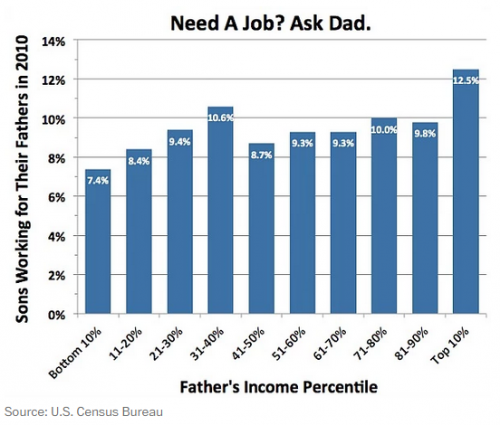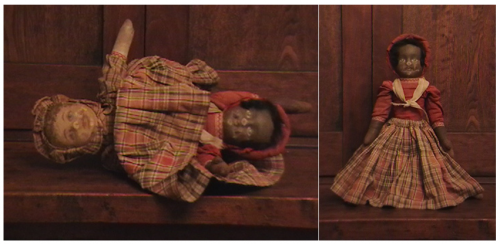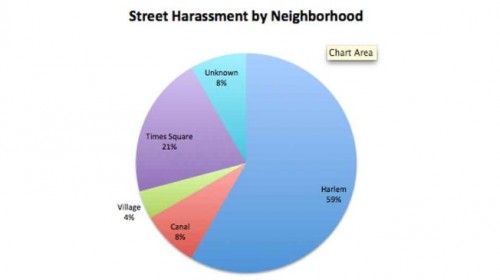A four minute introduction to Marxism, featuring Super Mario Bros., by Wisecrack:
Lisa Wade, PhD is an Associate Professor at Tulane University. She is the author of American Hookup, a book about college sexual culture; a textbook about gender; and a forthcoming introductory text: Terrible Magnificent Sociology. You can follow her on Twitter and Instagram.A new paper by Martha Stinson and Christopher Wignall found that 9.6% of working-age men were working for their dad in 2010. The likelihood of nepotistic opportunism was related to class, generally climbing with the father’s income.
This is just a “snapshot,” writes Matt O’Brien for The Washington Post. It’s just one year. If we consider whether men have ever worked for their dads, the numbers get much higher. More than a quarter of men spend at least some time working for the same company as their fathers before their 30th birthday. O’Brien also cites a study by economist Miles Corak revealing that 70% of sons of the 1% in Canada have worked at the same place as their dad.
As O’Brien says: “The easiest way to get your foot in the door is for your dad to hold it open for you.”
Cross-posted at Pacific Standard.
Lisa Wade, PhD is an Associate Professor at Tulane University. She is the author of American Hookup, a book about college sexual culture; a textbook about gender; and a forthcoming introductory text: Terrible Magnificent Sociology. You can follow her on Twitter and Instagram.Flashback Friday.
In a great book, The Averaged American, sociologist Sarah Igo uses case studies to tell the intellectual history of statistics, polling, and sampling. The premise is fascinating: Today we’re bombarded with statistics about the U.S. population, but this is a new development. Before the science developed, the concept was elusive and the knowledge was impossible. In other words, before statistics, there was no “average American.”
There are lots of fascinating insights in her book, but a post by Byron York brought one in particular to mind. Here’s a screenshot of his opening lines (emphasis added by Jay Livingston):
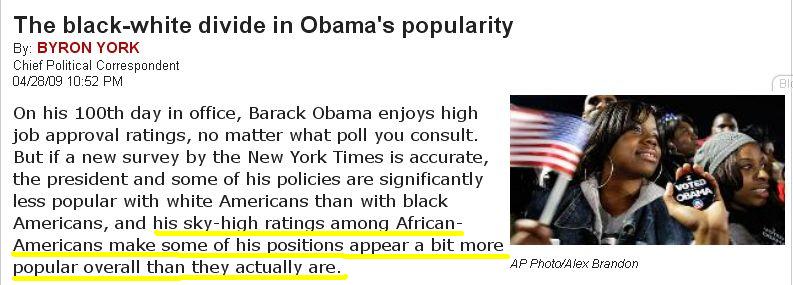
The implication here is, of course, that Black Americans aren’t “real” Americans and that including them in opinion poll data is literally skewing the results.
Scientists designed the famous Middletown study with exactly this mentality. Trying to determine who the average American was, scientists excluded Black Americans out of hand. Of course, that was in the 1920s and ’30s. How wild to see the same mentality in the 2000s.
Originally posted in 2009.
Lisa Wade, PhD is an Associate Professor at Tulane University. She is the author of American Hookup, a book about college sexual culture; a textbook about gender; and a forthcoming introductory text: Terrible Magnificent Sociology. You can follow her on Twitter and Instagram.In her provocative book, The Technology of Orgasm, Rachel Maines discusses a classic medical treatment for the historical diagnosis of “hysteria”: orgasm administered by a physician.
Maines explains that manual stimulation of the clitoris was, for some time, a matter-of-fact part of medical treatment and a routine source of revenue for doctors. By the 19th century, people understood that it was an orgasm, but they argued that it was “nothing sexual.” It couldn’t “be anything sexual,” Maines explains, “because there’s no penetration and, so, no sex.”
So, what ended this practice? Maines argues that it was the appearance of the vibrator in early pornographic movies in the 1920s. At which point, she says, doctors “drop it like a hot rock.” Meanwhile, vibrators become household appliances, allowing women to treat their “hysteria” at home. It wasn’t dropped from diagnostic manuals until 1957.
Listen to it straight from Maines in the following 7 minutes from Big Think:
Bonus: Freud was bad at this treatment, so he had to come up with some other cause of hysteria. After all, she says, “this was the guy who didn’t know what women wanted.” No surprise there, she jokes.
Cross-posted at Pacific Standard.
Lisa Wade, PhD is an Associate Professor at Tulane University. She is the author of American Hookup, a book about college sexual culture; a textbook about gender; and a forthcoming introductory text: Terrible Magnificent Sociology. You can follow her on Twitter and Instagram.Lisa Hix has written a really nice story, “Why Black Dolls Matter,” for Collectors Weekly. The history of the topsy-turvy doll really caught my interest. The one below is characteristic. Believed to be from the 1870s, it is the head and torso of a black and a white doll, sewed together in the middle with a long skirt. The doll can be flipped from one side to the other.
The general consensus seems to be that these dolls were primarily for enslaved children, but the purpose of the dolls isn’t clearly understood.
Hix quotes one of the founders of the National Black Doll Museum, Debra Britt, who says that the dolls enabled enslave children to have something forbidden: a doll that looked like them. “When the slave master was gone,” she explained, “the kids would have the black side, but when the slave master was around, they would have the white side.”
At wikipedia, though, the entry for the dolls cites the author of American Folk Dolls, who makes the opposite claim.
It has recently been suggested that these dolls were often made for Black children who desired a forbidden white doll (a baby like the ones their mothers cared for); they would flip the doll to the black side when an overseer passed them at play.
Kimberly Wallace-Sanders, author of Mammy: A Century of Race, Gender, and Southern Memory, suggests that the dolls might not have been disallowed at all. Since enslaved black women often cared for their own children and the children of their white captors, perhaps the doll was designed to socialize young enslaved girls into their future roles as mothers to children of both races. According to Historical Folk Toys, the black doll sometimes was dressed in a headscarf and the white doll in antebellum-style dress, supporting Wallace-Sanders’ theory that the idea was to socialize girls into their role.
And, of course, we have even less of an idea of how the children themselves thought of these dolls or where their imagination led them.
Cross-posted at Pacific Standard.
Lisa Wade, PhD is an Associate Professor at Tulane University. She is the author of American Hookup, a book about college sexual culture; a textbook about gender; and a forthcoming introductory text: Terrible Magnificent Sociology. You can follow her on Twitter and Instagram.First, there were the accolades. More than 100 instances of street harassment in a two minute video, testifying powerfully to the routine invasion of women’s lives by male strangers.
Then, there was the criticism. How is it, people asked, that the majority of the men are black? They argued: this video isn’t an indictment of men, it’s an indictment of black men.
Now, we’ve reached the third stage: lessons for research methods classes.
Our instructor is sociologist Zeynep Tufekci, writing at The Message. Our competing hypotheses are three:
1. Black men really do catcall more than other kinds of men.
2. The people who made this video are unconsciously or consciously racist, editing out men of other races.
3. The study was badly designed.
As Tufekci points out, any one of these could account for why so many of the catcallers were black. Likewise, all three could be at play at once.
Enter, the data wrangler: Chris Moore at Mass Appeal.
Moore and his colleagues looked for landmarks in the video in order to place every instance of harassment on the map of New York City. According to their analysis, over half of the harassment occurs on just one street — 125th — in Harlem.
Did the time the producers spent in Harlem involve denser rates of harassment, supporting hypothesis #1. Did they spend an extra amount of time in Harlem because they have something against black men? That’d be hypothesis #2. Or is it hypothesis #3: they were thoughtless about their decisions as to where they would do their filming.
Honestly, it’s hard to say without more data, such as knowing how much time they spent in each neighborhood and in neighborhoods not represented in the video. But if it’s true that they failed to sample the streets of New York City in any meaningful way — and I suspect it is — then hypothesis #3 explains at least some of why black men are over-represented.
And that fact should motivate us all to do our methods right. If we don’t, we may end up offering accidental and fallacious support to ideas that we loathe.
Cross-posted at Pacific Standard.
Lisa Wade, PhD is an Associate Professor at Tulane University. She is the author of American Hookup, a book about college sexual culture; a textbook about gender; and a forthcoming introductory text: Terrible Magnificent Sociology. You can follow her on Twitter and Instagram.If you’ve ever given an academic job talk or lecture, you’ve been this kid…
Via Next Scientist.
Lisa Wade, PhD is an Associate Professor at Tulane University. She is the author of American Hookup, a book about college sexual culture; a textbook about gender; and a forthcoming introductory text: Terrible Magnificent Sociology. You can follow her on Twitter and Instagram.Social mobility refers to likelihood that a person born in one social class will end up in another as an adult. A new study by Richard Reeves and Isabel Sawhill for the Brookings Institute offered a devastating picture of the possibilities for black youth. To summarize: most black children see downward mobility and are poorer as adults than they were as children.
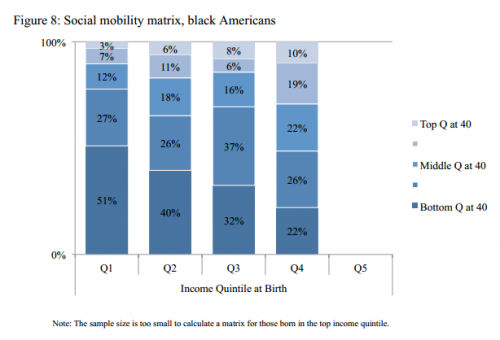 More than half of black children born into the poorest 1/5th of households will remain there as adults. That’s only true for 36% of similarly-situated Americans overall. Poor black children, then, are less likely than Americans in general to be able to escape poverty.
More than half of black children born into the poorest 1/5th of households will remain there as adults. That’s only true for 36% of similarly-situated Americans overall. Poor black children, then, are less likely than Americans in general to be able to escape poverty.
Black children born into the middle class — literally the middle 5th of Americans as measured by household income — overwhelmingly see downward mobility. 16% will remain somewhere in the middle, 14% will be richer than their parents, and a whopping 69% will end up less economically stable. In comparison, only 38% of Americans, overall, born into the middle 5th see a decline in their status as adults.
As you may have noticed from the hole in the far right of the chart, the researchers didn’t have enough cases to even estimate outcomes for blacks born rich.
Below is the data for whites (first) and all Americans (second) for comparison:
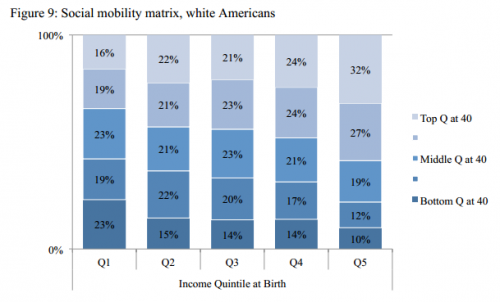
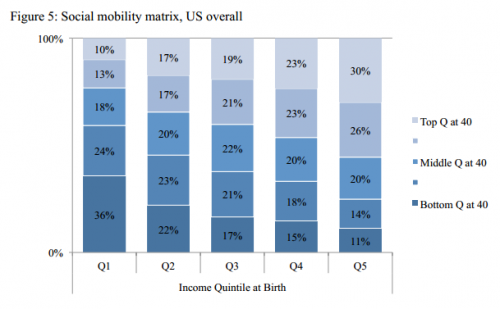 Here’s the first author, Richard Reeves, explaining social mobility, using Legos of course:
Here’s the first author, Richard Reeves, explaining social mobility, using Legos of course:
H/t Joe Feagin. Cross-posted at Pacific Standard.
Lisa Wade, PhD is an Associate Professor at Tulane University. She is the author of American Hookup, a book about college sexual culture; a textbook about gender; and a forthcoming introductory text: Terrible Magnificent Sociology. You can follow her on Twitter and Instagram.
